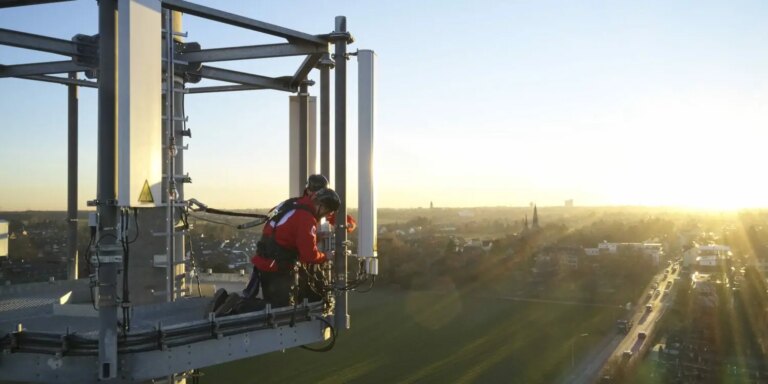During 2023, Germany’s largest carriers are focused on expanding their 5G networks, with some already serving more than 90% of the country’s population.
German telecommunications company Deutsche Telekom announced that its 5G network now covers 96% of Germany’s population. Deutsche Telekom’s 5G network has 80,000 5G antennas, of which more than 10,000 antennas are transmitted in the 3.6 GHz band in more than 800 cities and municipalities nationwide.
The carrier’s 5G technology currently offers download speeds of up to 1 Gbps, and the carrier expects 5G to reach 99% of Germany’s population by 2025.
Deutsche Telekom announced in August that 83% of its 5G mobile communications hubs nationwide are already connected with fiber optics.
The news agency also said more than 10,000 5G mobile sites now have fiber optic connections with 10 gigabit speeds, accounting for about 40% of all 5G mobile radio systems. Deutsche Telekom plans to equip more than 28,000 mobile sites with 10 Gigabit high-speed connections by 2026.
The company also highlighted that its 5G antennas at the 3.6 GHz frequency are particularly powerful as they are almost exclusively connected to the transport network with 10 Gigabit connectivity via fiber optics.
Deutsche Telekom added that the 3.6 GHz frequency band will complement the 5G frequencies in the 700 MHz and 2.1 GHz ranges already in use nationwide in Deutsche Telekom’s network. The 3.6 GHz frequency ensures especially high download speeds and smooth mobile coverage, especially in densely populated areas, the carrier said.
Deutsche Telekom has confirmed that it plans to launch 5G standalone (5G SA) services for residential customers in Germany next year.
Meanwhile, Vodafone Germany’s 5G network reached 91% of the country’s population by the end of 2023.
The carrier’s 5G standalone network (SA) currently serves nearly 45% of Germany’s population, the carrier added. Vodafone has previously stated that 5G SA technology will be covered nationwide by 2025.
Vodafone Germany launched its 5G standalone network last year in partnership with Ericsson, Nokia, Qualcomm and Oppo. For 5G expansion, Vodafone currently relies on frequencies in the 3.6 GHz, 1.8 GHz and 700 MHz bands in metropolitan, residential, suburban and rural areas across Germany.
Vodafone initially launched its 5G network in Germany in 2019 using the 3.5GHz spectrum it acquired from Telefonica in 2018.
O2 Telefonica, owned by Spanish telecommunications company Telefonica, also said its 5G network now reaches 95% of Germany’s population.
O2 Telefonica has added 5G technology to approximately 3,000 locations since the beginning of 2023.
In October, O2 Telefonica announced the launch of its 5G Standalone (SA) network in the country under the 5G Plus brand. Until this launch, the German telecommunications company had offered its 5G services through the NonStandalone (NSA) 5G architecture, partially through its LTE/4G core network.
The carrier’s 5G Plus uses frequencies in the 700 MHz, 1.8 GHz, and 3.6 GHz bands.
The company said it expects its 5G SA service to be fully covered in Germany by the end of 2025.
German carrier 1&1 also previously said it aims to offer 5G services to a quarter of German households by the end of 2025 and half of them by the end of 2030.
In August, 1&1 announced that it had entered into a long-term roaming agreement with German carrier Vodafone Germany to enable the provision of 5G services on a national level.
The German carrier said its 5G rollout plan calls for around 1,200 antenna masts to be in place by the end of 2023.


